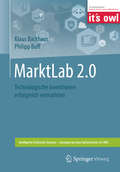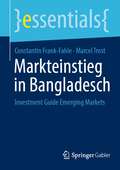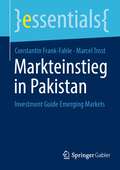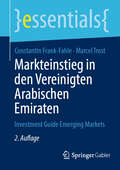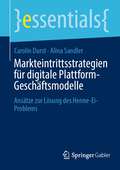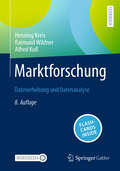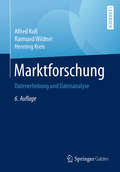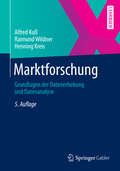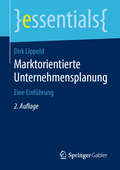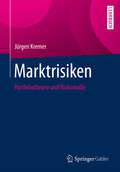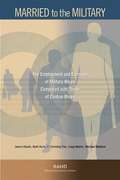- Table View
- List View
MarktLab 2.0: Technologische Inventionen erfolgreich vermarkten (Intelligente Technische Systeme – Lösungen aus dem Spitzencluster it’s OWL)
by Klaus Backhaus Philipp BuffDas vorliegende Buch fasst die Projektergebnisse der Nachhaltigkeitsmaßnahme "Marktorientierung" zusammen. Marktorientierung als Maßnahme zur Nachhaltigkeit sichert den Erfolg technologischer Neuentwicklungen, als Grundlage von Innovationen. Innovationen müssen evidente und latente Bedürfnisse befriedigen und einen Mehrwert zu bestehenden und konkurrierenden Lösungen bieten. Daher ist es unabdingbar, die Kundenpräferenzen bereits im Innovationsprozess zu erfassen und in der Produktentwicklung zu berücksichtigen. Ergebnisse der Forschung führen zur Entwicklung einer Methodik, mit der Kundenpräferenzen für neuartige technische Lösungen erhoben werden können, die noch nicht real existieren. Unternehmen erhalten damit praxisorientierte Hilfestellungen, um technologische Vorteile in Nutzenvorteile zu überführen. Mit den Ergebnissen können bereits frühzeitig im Innovationsprozess notwendige Anpassungen vorgenommen werden. Kern des Projektes ist ein Planmodul, das speziell für dieses Ziel konzipiert wurde. Die zweite Version (MarktLab 2.0) ist darauf gerichtet, ggf. auch frühzeitig Informationen zu gewinnen und in einem Marktmodell die Möglichkeit zu haben, alternative Lösungsansätze quasi "im Labor" zu testen. Online können ausgewählte Kunden zu Produktentwicklungen befragt werden, Alternativen der Entwicklung sogar schon mit Abgabepreisen dargestellt werden und eine Präferenzrangfolge erhoben werden. Soweit nötig wird dazu auf virtuelle Realität als Darstellungsform zurückgegriffen.
Markteinsteig in Saudi-Arabien: Investment Guide Emerging Markets (essentials)
by Constantin Frank-Fahle Marcel TrostDas Königreich Saudi-Arabien ist die größte Volkswirtschaft der Golfregion. Dieses essential führt den Leser durch praxisrelevante Rahmenbedingungen des Investitions-, Gesellschafts-, Steuer- und Arbeitsrechts, die für Investitionen in Saudi-Arabien aktuell gelten. Der Kurzleitfaden erläutert zudem den seit 2016 mit der Vision 2030 eingeleiteten wirtschaftlichen Transformationsprozess des Landes, aus dem zahlreiche Geschäftsmöglichkeiten erwachsen. Die Autoren sind erfahrene Rechtsanwälte mit eigener Kanzlei in den VAE und Saudi-Arabien.
Markteinstieg in Bangladesch: Investment Guide Emerging Markets (essentials)
by Constantin Frank-Fahle Marcel TrostBangladesch hat sich zu einer dynamischsten Volkswirtschaft entwickelt. Das junge Land profitiert seit vielen Jahren von beeindruckenden Wachstumsraten u.a. in der Textilwirtschaft. Das vorliegende Essential stellt einen Kurzleitfaden dar, der den Leser durch die rechtlichen und regulatorischen Rahmenbedingungen führt, die für Investitionen in Bangladesch gelten. Der Leitfaden behandelt die Gründung von Unternehmen, die geltenden Investitionsvorschriften, Sonderwirtschaftszonen und Investitionsanreize sowie die Besteuerung von Unternehmen und Investoren. Zusätzlich werden die Herausforderungen und Risiken erläutert, die mit Investitionen in Bangladesch verbunden sein können. Die Autoren sind erfahrene Rechtsanwälte mit einem eigenen Büro in Bangladesch und vermitteln dem Leser einen fundierten Einblick in die komplexe rechtliche und steuerliche Landschaft des Landes.
Markteinstieg in Pakistan: Investment Guide Emerging Markets (essentials)
by Constantin Frank-Fahle Marcel TrostPakistan hat sich als wichtiger Wirtschaftsakteur in Südasien etabliert. Dieser Kurzleitfaden bietet einen Überblick über die rechtlichen und regulatorischen Bedingungen für Investitionen in Pakistan, einschließlich Unternehmensgründung, Investitionsvorschriften, Sonderwirtschaftszonen, Besteuerung und Investitionsanreize. Dabei werden auch potenzielle Risiken aufgezeigt. Die Autoren, erfahrene Rechtsanwälte mit eigener Kanzlei in Pakistan, bieten einen tiefen Einblick in die rechtliche und steuerliche Situation des Landes.
Markteinstieg in den Vereinigten Arabischen Emiraten: Investment Guide Emerging Markets (essentials)
by Constantin Frank-Fahle Marcel TrostDie Vereinigten Arabischen Emirate (VAE) haben sich in den letzten Jahrzehnten zweifellos zu einem bedeutenden globalen Wirtschaftszentrum entwickelt. Das vorliegende Essential stellt einen Kurzleitfaden dar, der den Leser durch die rechtlichen und regulatorischen Rahmenbedingungen führt, die für Investitionen in den VAE gelten. Der Leitfaden behandelt die Gründung von Unternehmen, die geltenden Investitionsvorschriften, Freihandelszonen und Investitionsanreize sowie die Besteuerung von Unternehmen und Investoren. Zusätzlich werden die Herausforderungen und Risiken erläutert, die mit Investitionen in den VAE verbunden sein können. Die Autoren sind erfahrene Rechtsanwälte mit eigener Kanzlei in den VAE und vermitteln dem Leser einen fundierten Einblick in die komplexe rechtliche und steuerliche Landschaft des Landes.
Markteinstieg in den Vereinigten Arabischen Emiraten: Investment Guide Emerging Markets (essentials)
by Constantin Frank-Fahle Marcel TrostDie Vereinigten Arabischen Emirate (VAE) haben sich in den letzten Jahrzehnten zu einem bedeutenden globalen Wirtschaftszentrum entwickelt. Dieses essential führt durch die rechtlichen und regulatorischen Rahmenbedingungen, die für Investitionen in den VAE gelten. Der Kurzleitfaden behandelt die Gründung von Unternehmen, geltende Investitionsvorschriften, Freihandelszonen und Investitionsanreize sowie die Besteuerung von Unternehmen und Investoren sowie Herausforderungen und Risiken. Die überarbeitete 2. Auflage wurde infolge zahlreicher Reformen und Änderungen (u. a. Einführung einer Körperschaftsteuer, Reformierung des Arbeits- und Handelsvertreterrechts sowie Streichung der VAE von der grauen Liste der FATF) dem aktuellen Rechtsstand angepasst.
Markteintrittsstrategien für digitale Plattform-Geschäftsmodelle: Ansätze zur Lösung des Henne-Ei-Problems (essentials)
by Carolin Durst Alina SandlerDieses essential gibt einen Überblick über verschiedene Go-to-Market-Strategien für zweiseitige digitale Plattform-Geschäftsmodelle. Zunächst liegt der Fokus auf den Strategien zur sequenziellen, simultanen und viralen Kundenakquise. Im zweiten Teil zeigt der Beitrag, mit welchen Faktoren man positive Interaktionen fördert, um eine kritische Masse an Nutzern zu gewinnen.
Markterfolg durch zukunftsfähige Entscheidungen: Mit Strategie und Innovation den Wandel gestalten
by Peter GröndahlDieses Buch beschreibt, wie Sie wichtige, wirtschaftlich wirksame Entscheidungen erfolgreich treffen. In volatilen, unsicheren, komplexen und mehrdeutigen Situationen braucht es dazu gleichermaßen Analyse und Methodik wie Intuition und Haltung – ob als Unternehmer oder als Privatperson.Die Gründung oder Neuausrichtung von Unternehmen, die Einführung neuer Produkte, Investitionen in neue Technologien, aber auch private Entscheidungen wie Vermögensplanung oder Hausbau setzen eine fundierte Strategie voraus. Die zu ihrer Umsetzung notwendigen Entscheidungen sind nur dann erfolgreich, wenn Konzept, Timing, Umfeld und Zweck stimmig in sich und zum relevanten Umfeld sind.In diesem Buch finden Sie praxisbewährte und wissenschaftlich abgesicherte Methoden und Modelle, die statistisch zu besseren Ergebnissen führen; außerdem Checklisten, Entscheidungs- und Intuitionstrainings sowie einen Online-Test zur Überprüfung der relativen Stärke Ihres Innovationssystems. Der Autor stellt eine Methode vor, die Analyse und Intuition kombiniert und ein Innovationssystem aus der Zukunft heraus entwickelt. Das Buch hilft dabei, in einer Zeit dynamischen Wandels den Überblick zu bewahren und zukunftsfähige Entscheidungen zu treffen. Prof. Dr. Günter Faltin
Marktforschung für die Smart Data World: Chancen, Herausforderungen und Grenzen
by Thomas Wirth Bernhard Keller Hans-Werner Klein Alexandra Wachenfeld-SchellDie Methoden und Aufgaben der Marktforschung scheinen sich ständig zu verändern, aktualisieren sich und passen sich an Marktbedürfnisse an mit dem Ziel, eines zu erreichen: eine systemische Sicht auf Menschen, Daten und Dinge. Menschen bewegen sich im Web, nutzen unterschiedliche „Dinge“, sind „verdatet“ und generieren als Käufer, Nutzer oder Interessenten mehr Daten denn je. Der Glanz der Idee, dieses Füllhorn an Daten mittels Big Data Analytics und Künstlicher Intelligenz zu nützlichen Informationen und wertvollem Wissen fehlerlos automatisiert zu wandeln, bekommt immer mehr Flecken, denn was bei dieser Betrachtung fehlt, ist der Mensch. Umso mehr ist die Expertise der Marktforscher gefragt, die erweitert wird um das Wissen von Experten zu BlockChain Algorithmen, Gamification etc. Ebenso ist ein Überdenken der Leitplanken erforderlich, die eine moderne Ethik als Regeln des kommerziellen Prozesses setzen muss.Unternehmen brauchen Wissen über Präferenzen, Entscheidungsprozesse und Verhalten, um verwertbare Erkenntnisse zu generieren. Neu dabei ist die Vielfältigkeit der Orte, an denen Konsumenten und Bürger Informationen sammeln, selber zum Content beitragen und sich bewegen. Diese Vielfalt zu erfassen und der Analyse zugänglich zu machen, ist das Bestreben der modernen Marktforschung, sie setzt neben allen klassischen Instrumenten neue Wege und Verfahren ein – von Beacons, über passive Tracking-Verfahren bis hin zu künstlicher Intelligenz – alles, was dazu beiträgt, aus Daten smarte Daten zu machen, die die Geschichte der Menschen in ihren verschiedenen Rollen und Zusammenhängen erzählen. Marktforschung wird damit ebenso digital wie es die Gesellschaft ist. Den Weg und die Verfahren zu beschreiben, die zu relevanten Insights führen und dabei ebenso die Möglichkeiten, Chancen, Überschätzungen und Grenzen aufzuzeigen, ist das Anliegen dieses Buches. Verbunden damit gehen die Autoren auch der Frage nach, wie die zukünftigen Skills der Profession aussehen müssen, um die Geschichte der Daten zu verstehen und Daten zu wertvollen Informationen zu machen.
Marktforschung: Datenerhebung und Datenanalyse
by Alfred Kuß Raimund Wildner Henning KreisDieses Buch zeigt in gut verständlicher Weise die wesentlichen Grundlagen der Marktforschung auf, wie sie für Studium und Praxis des Marketing erforderlich sind. Ziel ist es, den Lesern ein solides Verständnis zentraler Aspekte der Datenerhebung und Datenanalyse zu vermitteln und damit die Basis für die Anlage und die verständige Anwendung von Marktforschungsuntersuchungen zu schaffen. In der 8. Auflage wurden alle Kapitel überarbeitet und aktualisiert. Aktuelle Themen, wie z.B. die Analyse qualitativer Daten (thematic analysis) und relevante Entwicklungen im Bereich künstlicher Intelligenz, wurden ergänzt. Zudem sind zahlreiche neue Beispiele hinzugekommen. Zusatzmaterial erhalten Sie via App: Laden Sie die Springer Nature Flashcards-App herunter und nutzen Sie exklusive Inhalte, um Ihr Wissen zu prüfen. Der Inhalt Forschungsprozess, Untersuchungsziele und Untersuchungsdesigns Repräsentative Befragungen und Stichprobenziehung Frageformulierung und Fragebogenentwicklung Qualitative Untersuchungen, Beobachtungen, Experimente, Desk Research einschließlich neuer, internetbasierter Formen Panels und Markttests Deskriptive Datenanalyse und Grundideen der schließenden Statistik Multivariate Analyseverfahren im Überblick Forschungsethik und Datenschutz
Marktforschung: Datenerhebung und Datenanalyse (Wissenschaft And Praxis Ser.)
by Alfred Kuß Raimund Wildner Henning KreisDieses Buch zeigt in gut verständlicher Weise die wesentlichen Grundlagen der Marktforschung auf, wie sie für Studium und Praxis des Marketing erforderlich sind. Ziel ist es, den Lesern ein solides Verständnis zentraler Aspekte der Datenerhebung und Datenanalyse zu vermitteln und damit die Basis für die Anlage und die verständige Anwendung von Marktforschungsuntersuchungen zu schaffen.In der 7. Auflage wurden alle Kapitel überarbeitet und um zahlreiche anschauliche Beispiele ergänzt. Aktuelle Entwicklungen in Bezug auf Online-Marktforschung, Datenaufbereitung, Signifikanztests und mobile Datenerhebung wurden integriert.Zusatzmaterial erhalten Sie via App: Laden Sie die Springer Nature Flashcards-App herunter und nutzen Sie exklusive Inhalte, um Ihr Wissen zu prüfen.Der InhaltForschungsprozess, Untersuchungsziele und UntersuchungsdesignsRepräsentative Befragungen und StichprobenziehungFrageformulierung und FragebogenentwicklungQualitative Untersuchungen, Beobachtungen, Experimente, Desk Research einschließlich neuer, internetbasierter FormenPanels und MarkttestsDeskriptive Datenanalyse und Grundideen der schließenden StatistikMultivariate Analyseverfahren im ÜberblickForschungsethik und Datenschutz
Marktforschung: Grundlagen Der Datenerhebung Und Datenanalyse (Wissenschaft And Praxis Ser.)
by Alfred Kuß Raimund Wildner Henning KreisDieses Buch zeigt in gut verständlicher Weise die wesentlichen Grundlagen der Marktforschung auf, wie sie für Studium und Praxis des Marketing erforderlich sind. Ziel ist es, den Lesern ein solides und tiefgehendes Verständnis zentraler Aspekte der Marktforschung zu vermitteln und damit die Basis für die Anlage und die verständige Anwendung von Marktforschungsuntersuchungen zu schaffen.In der 6. Auflage wurden alle Kapitel überarbeitet und aktualisiert. Neuere methodische Entwicklungen, nicht zuletzt in der Online-Marktforschung, wurden berücksichtigt.
Marktforschung: Grundlagen der Datenerhebung und Datenanalyse
by Alfred Kuß Raimund Wildner Henning KreisDie Autoren vermitteln in gut verständlicher Weise die wesentlichen Grundlagen der Marktforschung, wie sie für Studium und Praxis des Marketing erforderlich sind. Ziel ist es, den Lesern ein solides und tiefgehendes Verständnis zentraler Aspekte der Marktforschung zu vermitteln und damit die Basis für die Anlage und Verwendung von Marktforschungsuntersuchungen zu schaffen.In der 5. Auflage wurde das Buch in der neuen Autorenschaft übersichtlicher strukturiert. Alle Kapitel wurden überarbeitet, einzelne Teile wurden gestrafft, andere erweitert. Insbesondere der Praxisbezug bei Stichprobenziehung, Marketing-Testverfahren und Panels wurde deutlich ausgebaut. Zahlreiche Beispiele und weiterführende Hinweise kommen zur Vertiefung hinzu.
Marktgerechte Erbbaurechte: Wie Kommunen über Erbbaurechte bezahlbares Wohnen ermöglichen können
by Dirk LöhrIn den letzten Jahren entwickelte sich das Wohnen in den Ballungsräumen immer mehr von einer Grundvoraussetzung menschlicher Existenz zu einem Luxusgut. Vor 100 Jahren wurde in Deutschland das Erbbaurecht auch deswegen aus der Taufe gehoben, um bezahlbares Wohnen und Eigentumsbildung zu ermöglichen sowie der Spekulation auf dem Bodenmarkt entgegenzutreten. Zwar besinnen sich heute immer mehr Kommunen auf das Erbbaurecht, durchsetzen konnte sich dieses bislang jedoch nicht. Dirk Löhr geht in diesem Buch aus ökonomischer Sicht der Frage nach, warum dem so ist. Das Buch beschreibt, wie durch die Aufteilung einer Immobilie in die beiden Assetklassen „Grund und Boden“ sowie „Gebäude“ ein wirtschaftlicher Mehrwert gegenüber Volleigentum entstehen kann. Dieser Mehrwert könnte von Kommunen für die Bezuschussung bezahlbaren Wohnens verwendet werden. Die heutzutage gängigen Erbbaurechtsmodelle sind jedoch vollkommen ungeeignet, um dieses Potenzial zu heben. Eine andere, marktgerechte Anwendung ist daher nötig, um das Erbbaurecht zur "smarten Alternative" zu Volleigentum zu machen.Mit einem Geleitwort von Micheal Fabricius.
Marktorientierte Unternehmensplanung: Eine Einführung (essentials)
by Dirk LippoldDirk Lippold schildert die grundlegenden Faktoren, die bei einer marktorientierten Unternehmensplanung eine Rolle spielen. Das Essential beleuchtet die verschiedenen unternehmensinternen und -externen Einflussfaktoren und stellt sie im Rahmen von marktorientierten Analyse-Methoden in einen Wirkungszusammenhang. Darüber hinaus werden im Kontext des Planungsprozesses die Beziehungen zwischen Analyse, Zielen, Strategien und Maßnahmen herausgearbeitet.
Marktorientierte Unternehmensplanung: Eine Einführung (essentials)
by Dirk LippoldDirk Lippold erläutert in der 2., überarbeiteten Auflage des essentials die grundlegenden Parameter, die bei einer marktorientierten Unternehmensplanung eine Rolle spielen. Der Autor beleuchtet die verschiedenen unternehmensinternen und nun aktualisierten -externen Einflussfaktoren und stellt sie im Rahmen von marktorientierten Analyse-Methoden in einen Wirkungszusammenhang. Darüber hinaus werden im Kontext des Planungsprozesses die Beziehungen zwischen Analyse, Zielen, Strategien und Maßnahmen herausgearbeitet.
Marktpsychologie: Grundlagen und Anwendung
by Gerhard Raab Alexander Unger Fritz UngerDieses Buch liefert psychologische Erklärungen für das Verhalten von Menschen auf Märkten. Es beinhaltet einen umfassenden Überblick über psychologische Theorien, die für die Marktpsychologie relevant sind. Die Kernaussagen der Theorien und deren Erkenntnisse werden beschrieben und anhand typischer Fragestellungen aus dem Marktgeschehen illustriert. Die Anwendungsbeispiele stammen überwiegend aus dem Marketing und der Personalwirtschaft.Neu in der 5. AuflageDie fünfte Auflage wurde überarbeitet und aktualisiert. Das Kapitel „Ego-Depletion – Verlust an Kontrolle: Die Theorie begrenzter Ressourcen der Selbstkontrolle“ wurde vollständig überarbeitet und um die Revision des mechanistischen Ressourcenmodells von Michael Inzlicht und Brandon Schmeichel ergänzt.
Marktrisiken
by Jürgen KremerIn diesem Buch werden Konzepte zur Quantifizierung von Marktrisiken dargestellt. Im Rahmen der im ersten Kapitel vorgestellten Portfoliotheorie werden Kapitalanlagen charakterisiert, die nach Vorgabe eines Risikos eine möglichst hohe erwartete Rendite versprechen. Risiko wird hier definiert als die Standardabweichung der Portfoliorendite.Für arbitragefreie Ein-Perioden-Modelle lassen sich optimale Portfolios auch mithilfe von Wahrscheinlichkeitsdichten explizit angeben, und die Martingalmaße vollständiger arbitragefreier Marktmodelle lassen sich umgekehrt mithilfe des Marktportfolios und der Kovarianzmatrix der klassischen Portfoliotheorie darstellen, was im zweiten Kapitel ausgeführt wird.Im dritten Kapitel wird das wichtige Risikomaß Value at Risk vorgestellt, das den größten Verlust eines Portfolios quantifiziert, der mit einer vorgegebenen Wahrscheinlichkeit in einem vorgegebenen Zeitraum nicht überschritten wird. Neben der Delta-Normal-Methode zur näherungsweisen Berechnung des Value at Risk werden auch auf dieser Methode basierende Zerlegungen des Gesamtrisikos in Teilrisiken und Sensitivitäten des Value at Risk gegenüber Änderungen der Risikofaktoren behandelt.Der Value at Risk macht keine Aussagen über die Verteilung der hohen Verluste und er ist nicht subadditiv. Die Formulierung von Eigenschaften, die ein gutes Risikomaß haben sollte, führt zum Konzept der kohärenten Risikomaße, die im vierten Kapitel zusammen mit ihrem wichtigsten Vertreter, dem Expected Shortfall, vorgestellt werden. Der Expected Shortfall wird als kohärent nachgewiesen, und seine Berechnung wird für normalverteilte und lognormalverteilte Auszahlungen explizit angegeben.Jedes Kapitel endet mit einer Reihe von Aufgaben, für die sich im letzten Kapitel vollständige Lösungen finden.
Marktsegmentierung für Industriegütermärkte: Marktsegmente bilden, auswählen und bearbeiten in Business-to-Business-Märkten (essentials)
by Paul AmmannDieses essential beschreibt das Vorgehen der Segmentierung von Industriegütermärkten.B2B-Unternehmen weisen besondere Eigenschaften im Kaufverhalten auf, denn an der Kaufentscheidung sind mehrere Personen und Gremien beteiligt. Dies führt zu spezifischen Anforderungen für die Marktsegmentierung.In diesem Buch erfahren Sie, nach welchen Kriterien Industriegütermärkte segmentiert werden können und welche Methoden und Tools für die Bewertung und die Bearbeitung ausgewählter Segmente zur Anwendung kommen.
Marquee: Reinventing the Business of Nightlife
by Anita Elberse Ryan Barlow Sheldon WongIn January 2013, nightlife impresarios Jason Strauss and Noah Tepperberg are celebrating the re-opening of their famed New York City-based nightclub Marquee. While most clubs are over within their first one and a half years, Strauss and Tepperberg managed to keep Marquee one of NYC's hottest clubs for almost nine years. Meanwhile, they significantly expanded their portfolio of clubs in New York City, Las Vegas, and abroad. Now, after a costly renovation of Marquee New York City, would their investment pay off? Was it a wise idea to model the revamped club after its namesake in Las Vegas that had become North America's highest-grossing club by focusing on electronic dance music and featuring a high-profile DJ every night? Could Strauss and Tepperberg make the seemingly risky economics-which involved placing large bets on superstar DJs-work in a very different market?
Marquee: Reinventing the Business of Nightlife
by Anita Elberse Ryan Barlow Sheldon WongIn January 2013, nightlife impresarios Jason Strauss and Noah Tepperberg are celebrating the re-opening of their famed New York City-based nightclub Marquee. While most clubs are over within their first one and a half years, Strauss and Tepperberg managed to keep Marquee one of NYC's hottest clubs for almost nine years. Meanwhile, they significantly expanded their portfolio of clubs in New York City, Las Vegas, and abroad. Now, after a costly renovation of Marquee New York City, would their investment pay off? Was it a wise idea to model the revamped club after its namesake in Las Vegas that had become North America's highest-grossing club by focusing on electronic dance music and featuring a high-profile DJ every night? Could Strauss and Tepperberg make the seemingly risky economics-which involved placing large bets on superstar DJs-work in a very different market?
Marquee: The Business of Nightlife
by Anita Elberse Ryan Barlow Sheldon WongIn December 2008, nightlife impresario Noah Tepperberg is celebrating the fifth anniversary of his New York City nightclub Marquee. While most clubs are over within their first one-and-a-half years, Tepperberg has succeeded in keeping Marquee one of NYC's hottest clubs for what seems an eternity in the nightlife industry. However, concerns remain about Marquee's staying power, rising costs, and increased competition. When is the right time for Tepperberg to pull the plug on Marquee?
Married to the Military: The Employment and Earnings of Military Wives Compared with Those of Civilian Wives
by Craig Martin C. Christine Fair James Hosek Beth J. Asch Michael MattockFocusing on military wives' contribution to family income, the authors find that, in contrast to civilian wives, military wives are willing to accept lower wages rather than search longer for jobs. They work less than civilian wives if they have young children but more if their children are older; are less probable to work as they get older; and respond to changes in the unemployment rate as workers with a permanent attachment to the work force, not as "added workers."
Marriott Corp.
by Thomas R. PiperMarriott is considering the repurchase of ten million shares. This is apparently at odds with the financial policies that the Board of Directors passed two years earlier. Students must discuss why the policies were passed and why changes are now necessary. Includes a discussion of debt policy, financing policy and dividend policy. Students also discover stock is currently undervalued.
